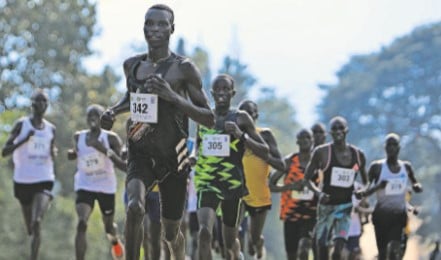Prime
The alluring Lake Mburo National Park

A hippo yawns in Lake Mburo National Park. A chinese tourist was on Saturday evening attacked and killed by hippo on the shores of Lake Naivasha in Nakuru County - Kenya. PHOTO | FILE | NATION MEDIA GROUP
What you need to know:
- The park was first gazetted in 1933 as a controlled hunting area and upgraded to a game reserve in 1963.
- Activities in the park include game drives in the rolling hills and open grasslands, boat trip along Lake Mburo, nature walk, sport fishing, forest walk in Rubanga which offers an opportunity to view different bird species, as well as adventure activities such as horseback riding and quad biking.
Shy, wild and fearful, an eland sprints and runs for dear life at the sight of a vehicle, threatening to crash into a herd of nearby zebras. Just outside the park boundary, a small herd of zebras peacefully grazes with the Ankole long horned cows.
In the evening, against the golden rays of the setting sun being reflected on the calm waters of Lake Mburo, a dozen submerged hippos surface and take turns to yawn at the camera. In the reeds on the banks of the lake, the African Finfoot dashes for cover the moment it hears the humming sound from the engine of an approaching boat. That is what makes Lake Mburo National Park unique. It is different.
Size just does not count
Measuring 370km2, Lake Mburo is Uganda’s smallest savannah park. Located in Kiruhura District, about 240 km from Kampala, the park is one of most easily and cheaply accessible parks in the country.
Small as it is, it is home to 350 bird species with varied habitats that support 68 mammal species. It also hosts the Burchell’s zebra and eland which apart from Lake Mburo, can only be found in Kidepo National Park. Though it has a variety of birds and animals, it is the only place in the country with impalas.
Home of antelopes
The impala is one of the most graceful of antelopes. It is slender, agile and can run at more than 60km/h. It can leap up to 10m in length and 3m in height both for enjoyment and while running away from danger. Impala males are known as rams and females as ewes. Females have no horns. Male impalas produce a scent from a gland on their foreheads to advertise their status to rivals. The scent fades when the male loses rank. Males will fight for status and territory throughout the mating season. Most young impalas are born around mid-day as this is the safest time to give birth since most of their enemies are resting.
The shy eland is one of the unique attractions in Lake Mburo National Park. The eland is the slowest antelope, with a peak speed of 40kms per hour. Elands are massive creatures. A bull can weigh up to 900Kgs. They tire very quickly but can maintain a 22kms per hour trot indefinitely. elands are capable of jumping up to 2.5 metres from a standing start when startled while young ones can jump up to 3 metres high. They live up to between 15 to 20 years in the wild and up to 25 in captivity.
It is the only park in Uganda where you can see the long horned Ankole cattle grazing with zebras outside the park boundary because of the park’s history.

Zebras graze alongside the Ankole-long horned cattle. This is a common scenery in Lake Mburo.
The park was first gazetted in 1933 as a controlled hunting area and upgraded to a game reserve in 1963. In 1983, it was upgraded to a national park and the pastoralists who used to graze their animals in the area were evicted.
Less than half of the park’s original land area was eventually re-gazetted by the NRM government in 1986 and given to the community but the animals, especially the zebras do not know that. When you see them grazing with cattle, the zebras are within their original ranges. There is nowhere in Uganda that zebras can be sighted in such great numbers than in Lake Mburo National Park.
The park’s wonders
Lake Mburo National Park has five lakes including Lake Mburo from which it gets its name. The lakes are home to about 300 hippos that usually stage a yawning contest in the evenings. There is nowhere else in Uganda you will see yawning hippos silhouetted against the best sunsets in the country. During game drives, a variety of other animals can be sighted. These include buffaloes, leopards, warthogs, oribi, defassa waterbuck, hyena, topi and reedbuck. Recently, 15 giraffes were translocated to Lake Mburo from Murchison Falls National Park.
As for birds, apart from the frighten African finfoot, the park supports globally threatened species of birds including 22 species of Palaearctic and Afro-tropical migrant birds. Other birds include but are not limited to the Red-faced Barbet, only seen in Lake Mburo, the endemic African Finfoot and the rare Shoebill. Other key species are the papyrus yellow warbler, saddle-billed stork, brown-chested lapwing, African-wattled lapwing, carruther’s cisticola, tabora (long-tailed) cisticola, African scops owl, Abyssinian ground hornbill and white-winged warbler, blue-breasted kingfisher, hairy-breasted barbet and yellow-rumped tinkerbird, among others.
Fun in the park
Activities in the park include game drives in the rolling hills and open grasslands, boat trip along Lake Mburo, nature walk, sport fishing, forest walk in Rubanga which offers an opportunity to view different bird species, as well as adventure activities such as horseback riding and quad biking.




